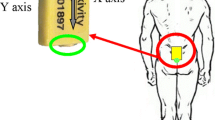Summary.
Cognitive processes can influence balance in various ways, but not all changes in postural performance can easily be identified with the naked clinical eye. Various studies have shown that dynamic posturography is able to detect more subtle changes in balance control. For patients with Parkinson’s disease (which is typically an asymmetric disease), changes in the symmetry of balance control might provide a sensitive measure of cognitive influences on balance. Here, we describe a new posturography technique that combines dynamic platform perturbations with system identification techniques to detect such asymmetries in balance control of two patients with Parkinson’s disease. Results were compared to those of six healthy controls. Our pilot data show clear asymmetries in dynamic balance control, even though patients themselves were not aware of this and had no subjective problems with stability or standing. We also found asymmetries in weight bearing, but the asymmetries in dynamic balance contribution were larger. Finally, asymmetries in weight bearing and dynamic balance in patients were not tightly coupled as in healthy controls. Future studies could incorporate this approach when examining the influence of mental decline on postural regulation.
Similar content being viewed by others
References
O Blin AM Ferrandez G Serratrice (1990) ArticleTitleQuantitative analysis of gait in Parkinson patients: increased variability of stride length J Neurol Sci 98 91–97 10.1016/0022-510X(90)90184-O Occurrence Handle10.1016/0022-510X(90)90184-O Occurrence Handle1:STN:280:DyaK3M%2FjvVWhsQ%3D%3D Occurrence Handle2230833
BR Bloem YA Grimbergen JG van Dijk M Munneke (2006) ArticleTitleThe “posture second” strategy: a review of wrong priorities in Parkinson’s disease J Neurol Sci 248 196–204 10.1016/j.jns.2006.05.010 Occurrence Handle10.1016/j.jns.2006.05.010 Occurrence Handle16806270
R Djaldetti I Ziv E Melamed (2006) ArticleTitleThe mystery of motor asymmetry in Parkinson’s disease Lancet Neurol 5 796–802 10.1016/S1474-4422(06)70549-X Occurrence Handle10.1016/S1474-4422(06)70549-X Occurrence Handle16914408
RC Fitzpatrick D Burke C Gandevia (1996) ArticleTitleLoop gain of reflexes controlling human standing measured with the use of postural and vestibular disturbances J Neurophysiol 76 3994–4008 Occurrence Handle1:STN:280:DyaK2s7jvV2isw%3D%3D Occurrence Handle8985895
AC Geurts TW Mulder B Nienhuis RA Rijken (1992) ArticleTitlePostural reorganization following lower limb amputation. Possible motor and sensory determinants of recovery Scand J Rehabil Med 24 83–90 Occurrence Handle1:STN:280:DyaK383psVyisA%3D%3D Occurrence Handle1604266
JM Hausdorff JD Schaafsma Y Balash AL Bartels T Gurevich N Giladi (2003) ArticleTitleImpaired regulation of stride variability in Parkinson’s disease subjects with freezing of gait Exp Brain Res 149 187–194 Occurrence Handle1:STN:280:DC%2BD3s%2FpslagtQ%3D%3D Occurrence Handle12610686
AJ Hughes SE Daniel L Kilford AJ Lees (1992) ArticleTitleAccuracy of clinical diagnosis of idiopathic Parkinson’s disease: a clinico-pathological study of 100 cases J Neurol Neurosurg Psychiatry 55 181–184 10.1136/jnnp.55.3.181 Occurrence Handle10.1136/jnnp.55.3.181 Occurrence Handle1:STN:280:DyaK383is1Omsg%3D%3D Occurrence Handle1564476
SH Keus BR Bloem EJ Hendriks AB Bredero-Cohen M Munneke (2006) ArticleTitleEvidence-based analysis of physical therapy in Parkinson’s disease with recommendations for practice and research Mov Disord 22 IssueID4 451–460 10.1002/mds.21244 Occurrence Handle10.1002/mds.21244
B Koopman HJ Grootenboer HJ de Jongh (1995) ArticleTitleAn inverse dynamics model for the analysis, reconstruction and prediction of bipedal walking J Biomech 28 1369–1376 10.1016/0021-9290(94)00185-7 Occurrence Handle10.1016/0021-9290(94)00185-7 Occurrence Handle1:STN:280:DyaK287gsFOlug%3D%3D Occurrence Handle8522549
R Marchese M Bove G Abbruzzese (2003) ArticleTitleEffect of cognitive and motor tasks on postural stability in Parkinson’s disease: a posturographic study Mov Disord 18 652–658 10.1002/mds.10418 Occurrence Handle10.1002/mds.10418 Occurrence Handle12784268
SL Mitchell JJ Collins CJ De Luca A Burrows LA Lipsitz (1995) ArticleTitleOpen-loop and closed-loop postural control mechanisms in Parkinson’s disease: increased mediolateral activity during quiet standing Neurosci Lett 197 133–136 10.1016/0304-3940(95)11924-L Occurrence Handle10.1016/0304-3940(95)11924-L Occurrence Handle1:CAS:528:DyaK2MXos1ajtL8%3D Occurrence Handle8552278
M Plotnik N Giladi Y Balash C Peretz JM Hausdorff (2005) ArticleTitleIs freezing of gait in Parkinson’s disease related to asymmetric motor function? Ann Neurol 57 656–663 10.1002/ana.20452 Occurrence Handle10.1002/ana.20452 Occurrence Handle15852404
L Rocchi L Chiari FB Horak (2002) ArticleTitleEffects of deep brain stimulation and levodopa on postural sway in Parkinson’s disease J Neurol Neurosurg Psychiatry 73 267–274 10.1136/jnnp.73.3.267 Occurrence Handle10.1136/jnnp.73.3.267 Occurrence Handle1:STN:280:DC%2BD38vivVOlsg%3D%3D Occurrence Handle12185157
A Samii JG Nutt BR Ransom (2004) ArticleTitleParkinson’s disease Lancet 363 1783–1793 10.1016/S0140-6736(04)16305-8 Occurrence Handle10.1016/S0140-6736(04)16305-8 Occurrence Handle1:CAS:528:DC%2BD2cXksVanu7k%3D Occurrence Handle15172778
JGP Schoukens R Pintelon (1993) Design of broadband excitation signals G Keith (Eds) Perturbation signals for system identification Prentice Hall, Englewood Cliffs USA
PC Su HM Tseng HH Liou (2002) ArticleTitlePostural asymmetries following unilateral subthalomotomy for advanced Parkinson’s disease Mov Disord 17 191–194 10.1002/mds.1269 Occurrence Handle10.1002/mds.1269 Occurrence Handle11835462
EH van Asseldonk JH Buurke BR Bloem GJ Renzenbrink AV Nene FC van der Helm H van der Kooij (2006) ArticleTitleDisentangling the contribution of the paretic and non-paretic ankle to balance control in stroke patients Exp Neurol 201 441–451 10.1016/j.expneurol.2006.04.036 Occurrence Handle10.1016/j.expneurol.2006.04.036 Occurrence Handle16814283
H van der Kooij E van Asseldonk FC van der Helm (2005) ArticleTitleComparison of different methods to identify and quantify balance control J Neurosci Methods 145 175–203 10.1016/j.jneumeth.2005.01.003 Occurrence Handle10.1016/j.jneumeth.2005.01.003 Occurrence Handle15922036
Author information
Authors and Affiliations
Rights and permissions
About this article
Cite this article
van der Kooij, H., van Asseldonk, E., Geelen, J. et al. Detecting asymmetries in balance control with system identification: first experimental results from Parkinson patients. J Neural Transm 114, 1333–1337 (2007). https://doi.org/10.1007/s00702-007-0801-x
Received:
Accepted:
Published:
Issue Date:
DOI: https://doi.org/10.1007/s00702-007-0801-x




